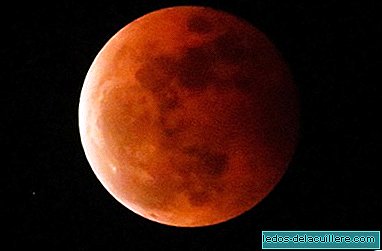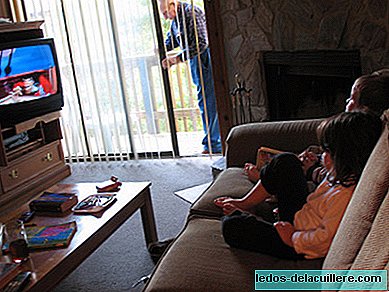
They are on vacation, we don't have to get up early tomorrow and the weather is good. There is no excuse to enjoy a magical family night!
Tonight, starting at 9:15 p.m., we will be able to see in Spain how the moon enters the gloom of the Earth to take the appearance of a 'blood moon'. Or what is the same, a lunar eclipse where the moon will not disappear, but will take on an intense red (or brownish) color.
But there is something even more special in this eclipse: its duration. It will be three hours and 55 minutes of eclipse, from when it begins to enter the twilight zone of the Earth until it leaves it. And 42 minutes and 57 seconds of total eclipse. It will be the longest eclipse of the 21st century!
Where will it look?
It will start at 9:30 p.m. (approximately, depending on the place of observation) and will last until 11:13 p.m. Then the moon will begin to escape the shadow of the Earth until recover normalcy already at dawn, around 01:30.
It can be seen in almost all of Europe, Africa, the Middle East, part of Central Asia and in South America.
In Spain we can enjoy this wonder from the beginning of the total phase. For example:
In Madrid the eclipse will begin at 20:24 h, although the moon will not rise until an hour later.
In the western half of the Peninsula and in the Canary Islands, the moon will emerge totally eclipsed.
In the eastern half of the Peninsula and the Balearic Islands, the moon can be seen before the start of the total phase.
What is a lunar eclipse?
Moon eclipses are an astronomical phenomenon in which the Earth stands between the Sun and the Moon, casting their shadow on the satellite. The Sun, the Earth and the Moon are aligned and the Earth prevents the sun's rays from reaching the Moon.
Although every 29 days we have our satellite in full phase, an eclipse does not occur every month because the lunar orbit is deviated about 5 degrees from the Earth's orbit around the Sun. So only every two years, on average, is the proper alignment usually produced to give rise to a lunar eclipse, a true cosmological coincidence.
Do you want your children to understand it better? You can do a simple experiment: place a ball between a light and a wall and make it look at the shadows that are projected on the wall.
And why do we see the red moon?
The explanation is optical: the sunlight that passes through the atmosphere is "filtered" by the earthly air that disperses the shortest wavelengths. Only reddish colors reach the surface of the Moon.
What do we need to see it?
No special equipment is required to observe lunar eclipses. That is, they can be seen safely directly with the naked eye or with telescopes because they do not harm your eyesight.
It is best to look for an area away from light pollution offered by overcrowded nuclei. We need a 'black sky', essential to correctly observe the sky. If you are on vacation in a rural area, at sea or in the mountains, you have it easy!
Another option would be to go directly to small, medium and large astronomical observatories from which we will have all the facilities to enjoy the event.

A family plan with the help of technology
Children love the apps, But are not the only ones. While we wait for the moon to hide, you can better understand how an eclipse works or go looking in the sky for the brightest stars. Here are some ideas to enjoy an unforgettable night.
1. Choose where to view the eclipse
Do not waste any more time and enter Dark Sky Map (for Android) or Dark Sy Meter (for iOS). They will help you to locate the areas of 'black sky', or what is the same, with less light pollution, essential to correctly see the stars, planets and our satellite, the moon. This way you will know that a nearby place is the most appropriate to see the eclipse tonight.
2. Schedule the night getaway
Before leaving home, remember to pack a small backpack with the essentials so that everything is perfect.
A flashlight to move through that dark place chosen. The mobile phone flashlight can also be used.
Take a jacket or some coat. Keep in mind that the eclipse will last until dawn and can cool.
Be proactive and include water and gastronomic contribution (of your liking) in case you get hungry in the middle of nowhere. With children you never know!
You can download Eclipse Calculator and check it out at home. You can also review it with them at the place of observation, while you are watching the progression of the eclipse. You will discover when the next eclipses will take place and from where they can be seen.
3. Identify the stars of the sky
You are already sitting comfortably on the floor on a blanket or in comfortable folding chairs. What better time to discover the wonders of heaven! Star Walk 2 helps you. You just have to direct the phone to the sky to identify and obtain information of all the stars, planets and constellations that are seen in real time.
4. Immortalize the 'red' moment
If you like photography, you will surely be armed with all the necessary equipment. If you want to make sure to photograph the eclipse at the best time, PhotoPills, calculate it for you.
But if you don't have a reflex camera, nothing happens either. You can directly attach the lens of your camera (serves that of your mobile phone) with the binoculars or telescope and, with a little pulse, shoot and get the snapshot.
You may need to shoot several times until the picture is not moved. But you have time because the eclipse is very long, so why don't you let children try their luck too?
5. Travel to space
If the astronomy bug has bitten you, it is time to learn more while the moon is recovering its usual appearance. NASA Visualization Explorer allows a direct connection to the fleet of NASA research spacecraft. You will be surprised with their latest findings and travel to remote places in space without moving from Earth. And, as it is in English, you can take advantage to practice the language with the children.
The partial eclipse begins at 20.25 and will end at 00.19 hours, while the total begins at 21.30 until 23.13.Events organized by astronomers
If the eclipse catches you in a big city and you still don't have plans to see it with your children, we propose some activities to 'skip the light pollution' of the city for free.
In addition, observing the eclipse through telescopes and with the help of astronomy experts will allow you to see Mars like never before. This planet will also be the brightest celestial object in the sky since it is the smallest distance from Earth since 2003!
"Fiesta del Solar Sistema", in The Museum of Science and the Cosmos (MCC) in Tenerife, with the participation of the Institute of Astrophysics of the Canary Islands (IAC). From 21 to 23 hours. One night to observe the eclipse of Luna with telescopes and see the planets Venus, Jupiter, Saturn and Mars.
Planetarium in Madrid. From 10 at night, you can see the solar eclipse for free through different telescopes. In addition, the blood moon will be projected on the main facade of the building. And it will have the expert collaboration of the Astronomical Association of Madrid (AAM).
The Valencian Astronomy Association in Valencia, organized in the Garden of Astronomy of the Umbracle, of La Ciutat de les Arts i les Ciències, an observation with telescopes of the eclipse of Luna from 9:15 at night.
Astronomical Observatory of Cantabria. In Santander, from 9:30 p.m. to 00:30 a.m. Free activity, which does not require prior registration. Astronomers recommend carrying binoculars. They will also make a special radio program from 8 pm to explain the phenomenon to those who cannot approach.
Cosmocaixa de Barcelona. You can observe the Moon through telescopes and watch the event projected on a large screen. Experts and fans of the sky will explain all the details of the eclipse.
In Babies and More Night of the Perseids, how and where to enjoy the rain of summer stars with children, Summer with children: 11 campsites to enjoy nature with the family












